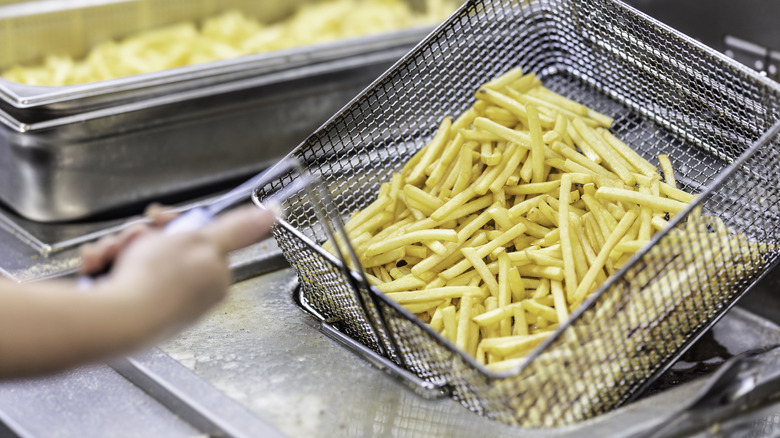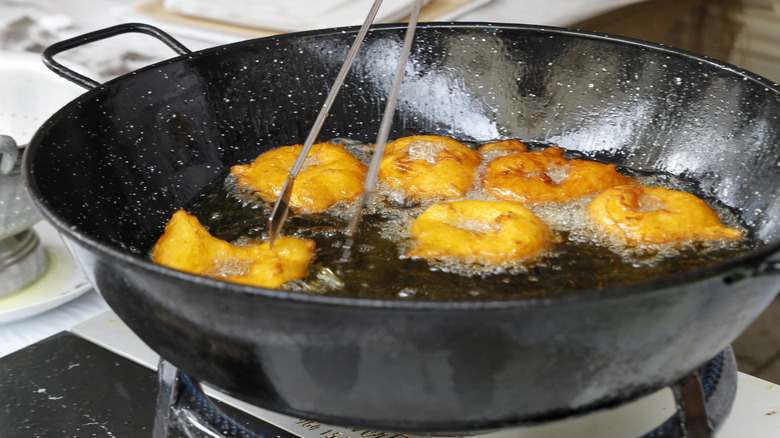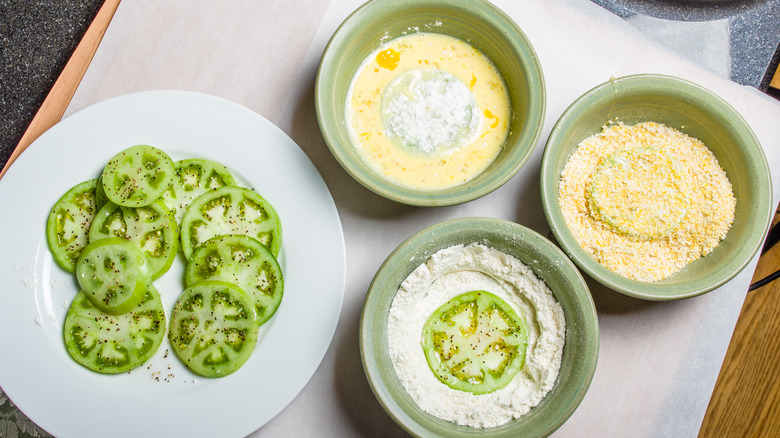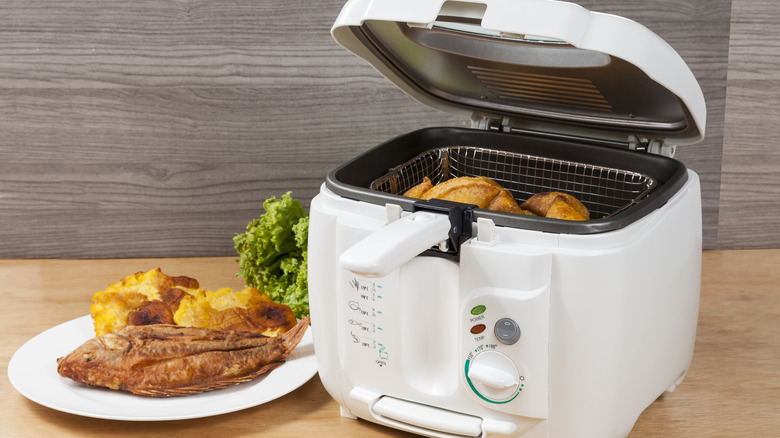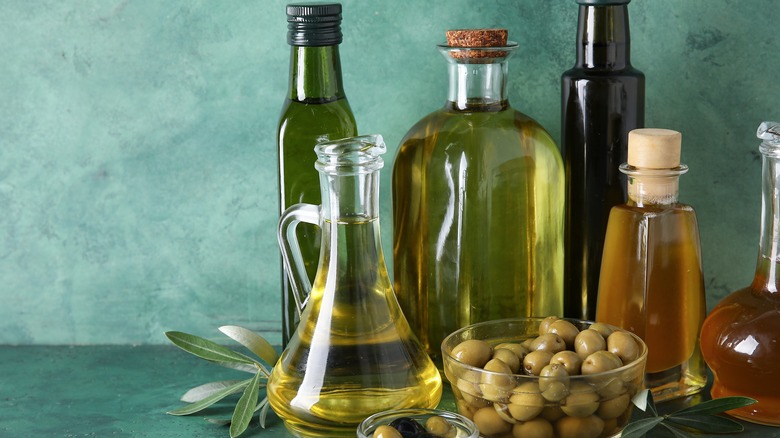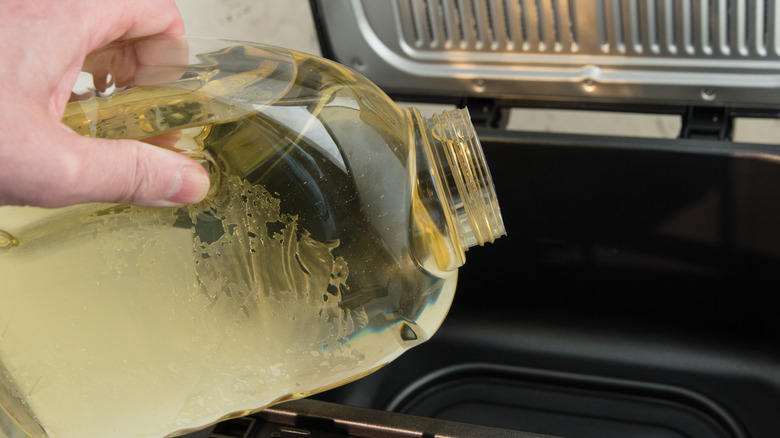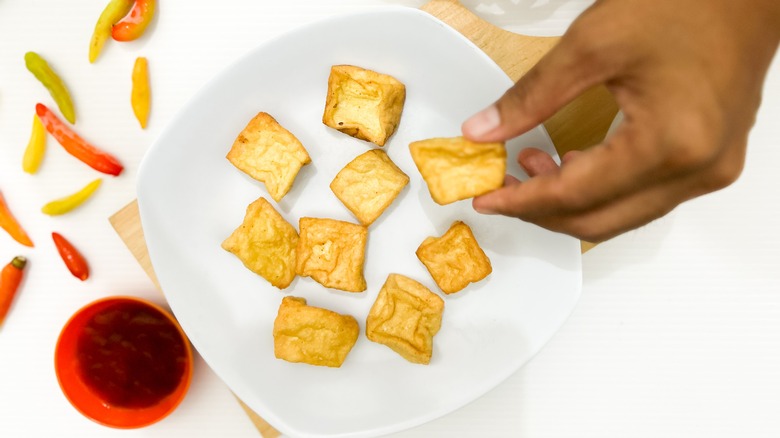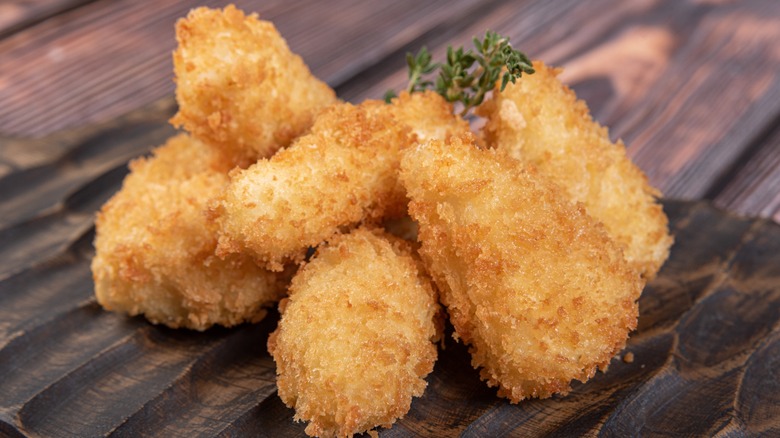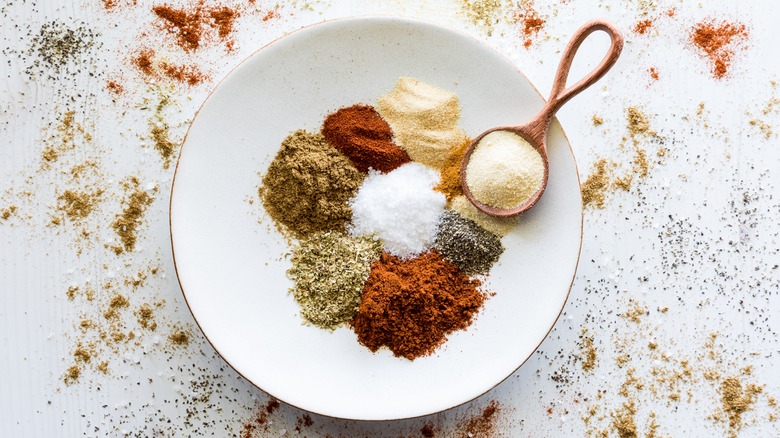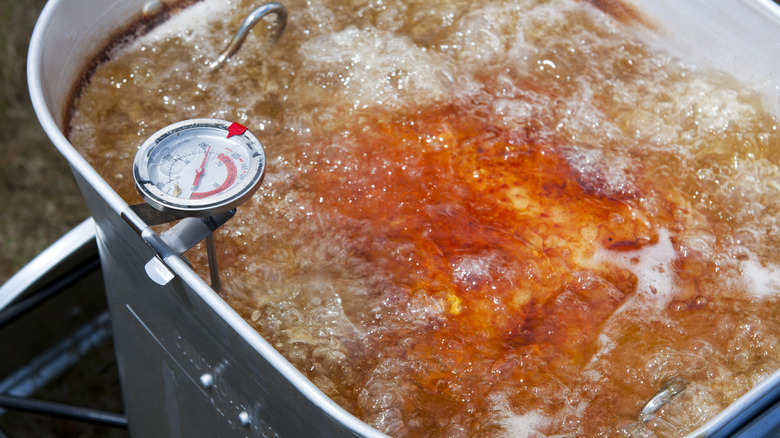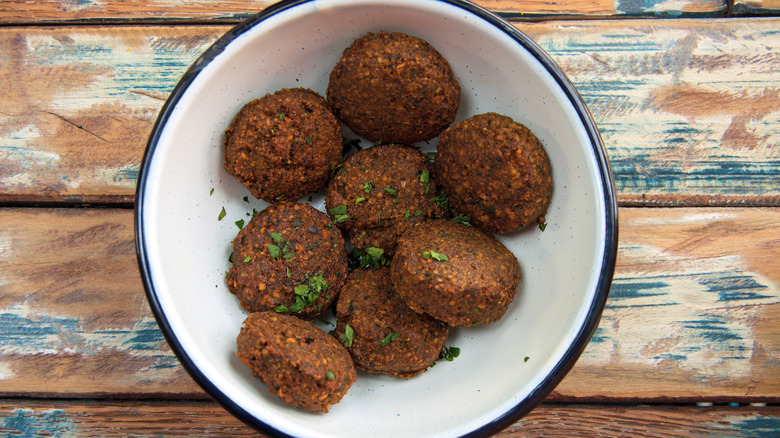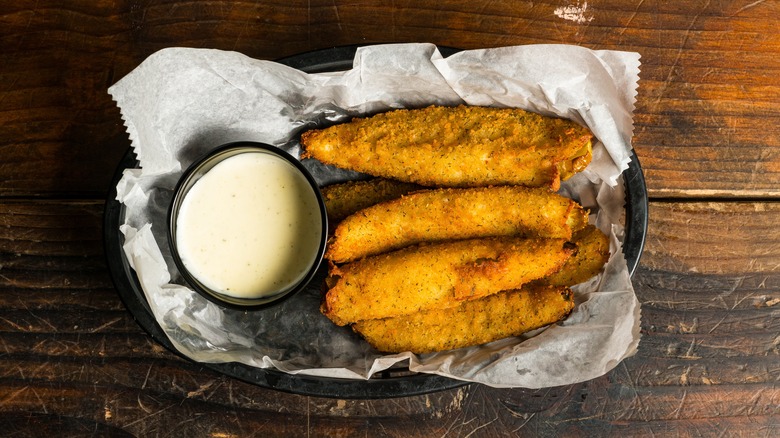Common Myths About Deep Frying Experts Want You To Stop Believing
Deep frying is the final frontier for many home cooks. You might be confident cooking with pretty much any other method, but afraid of deep frying because you've heard too many horror stories. Or, perhaps you've deep fried a few times before and found it tricky or had a few mishaps. Either way, you may have fallen for some common deep frying myths and misconceptions.
It's hugely common for people to assume that deep frying is hard, or that it always has to be messy. Then, there's the food itself — a lot of folks think of deep fried food as greasy across the board, but it doesn't have to be. And this is just the tip of the iceberg when it comes to misconceptions about this cooking method. We know that deep frying can be a great tool to have in your culinary arsenal, so we wanted to get to the bottom of things. We interviewed three food and cooking experts who regularly deep fry food to help understand these frequently believed fallacies and the reality behind them.
Below, you'll find 11 common myths about deep frying that experts want you to stop believing. Not only have our experts shed light on what these misconceptions are but they've explained the truth behind them. This should help you get more confident with the idea of deep frying, or learn some tips and which deep frying mistakes to avoid when you want to give it a go yourself.
Myth: Deep frying is difficult
Whenever deep frying comes up in conversation, people often say they could never do it at home because it's just too difficult. The fact is, this just isn't the case. Deep frying isn't particularly tricky. Though, of course, like any cooking technique, it can seem daunting until you learn the ropes. So, it's not that it's especially difficult, but there's as much of a learning curve as there is with figuring out how to knead bread or how to cook pasta perfectly al dente.
"I get why people might think deep frying is tricky, but it's really not that bad once you get the hang of it," says Marye Audet-White, a cookbook author and food blogger at Restless Chipotle. "The key is having the right setup and knowing a few basic tips. It's all about maintaining the right temperature and not overcrowding the fryer."
Amber Fletcher is the co-owner of Fletcher's Original Corny Dogs and has worked in the family business since she was a kid. "Deep frying can seem overwhelming at first, but it's all about a bit of curiosity and a willingness to experiment," she tells us. "I started frying corny dogs in our family business when I was barely even a teenager and it quickly became one of my favorite ways to pass the time at work, always trying to make each corny dog symmetrical and golden brown." So, it's something you might come to love if you give it a chance.
Myth: Deep frying is always messy
We're not going to lie, deep frying has the potential to be messy. Oil spatter, drips of batter, and breadcrumbs can find their way all over your kitchen if you aren't careful. But, it certainly isn't always messy and there are ways to keep on top of things so any potential mess stays in check. "With a little preparation, you can keep things under control," says Marye Audet-White, who has more than 30 years of experience as a recipe and cooking expert. "Use a deep, heavy-bottomed pot to minimize splatter, and keep a splatter screen handy. Cleaning up immediately after frying also helps keep the mess manageable."
Of course, it also depends on what volume of frying you're doing. If you're making a batch of tempura or french fries for your household, you can probably keep the mess in check. But, if you're making food for a huge crowd, it's likely to get messier. "Often at the end of the day working an event I can be covered in a mixture of batter and powdered sugar," remarks corn dog expert Amber Fletcher. "A splatter of batter is to be expected, just be cautious not to splatter the oil."
Keeping the area where you dredge or coat your ingredients as close to the stove or fryer as possible can help avoid drips. And, some people find it's less messy using a deep fryer than a pot on the stovetop.
Myth: You need a deep fat fryer
When you think of frying food at home, you might picture the kind of deep fat fryer that you'd find in your grandparents' kitchen. But, you actually don't need a dedicated fryer to cook food in this way. In fact, you probably already own a pan you could use for deep frying.
"While a deep fat fryer can make things easier, you don't need one," notes cookbook author and food blogger Marye Audet-White. "A large pot or Dutch oven works just fine. Just make sure it's deep enough to hold the oil and has enough room so the food can float freely."
"Other alternatives you might already have at home include a wok or a cast iron skillet," says food blogger and recipe developer Becky Hardin of The Cookie Rookie. "A wok is particularly good due to its shape, which allows for even heating and requires less oil than a traditional pot. A deep cast iron skillet can also be used, as it retains heat well and provides a stable frying environment." She notes that cast iron skillets aren't her top choice as they can be more messy. There's also more chance of oil splatter, which isn't ideal.
You can also buy smaller alternatives to full-size deep fat fryers. "At home I use a Fry Daddy," Amber Fletcher of Fletcher's Original Corny Dogs tells us. It uses 4 cups of oil — significantly less than a standard fryer.
Myth: Olive oil isn't suitable for deep frying
One of the most common myths we've encountered is that olive oil isn't suitable for deep fat frying. We hear it all the time, but it's not true. It's usually linked to the perceived smoke point of olive oil. The smoke point of an oil is the temperature at which it begins to break down and produce visible smoke. At this point, the oil starts to degrade, potentially creating harmful compounds and imparting unpleasant flavors to food. People say that olive oil has too low a smoke point for deep frying, and while it isn't the oil with the highest smoke point, it's up there.
For deep frying, you generally need to heat oil to between 350 F and 370 F. So, if an oil's smoke point is lower than this, it isn't suitable for deep frying. The smoke point for refined olive oil is between 390 F and 470 F, which is quite a range, but even at its lowest, the smoke point is well above the temperature at which you'd be deep frying. In fact, the USDA even lists it as one of the types of oils that are safe to use for deep frying.
But, just because olive oil is safe and suitable for deep frying, it doesn't mean you'll want to use it. Some people find the flavor too overpowering. It works for certain foods, but with others you don't want an olive oil taste.
Myth: Deep frying wastes a lot of oil
Among the reasons some people are reluctant to deep fry is that they believe it wastes a lot of oil. There's some truth behind this myth — you do need a fairly large quantity of oil for deep frying. However, it might not go to waste like you think it will. If you fry even semi-regularly, you could get more use out of that oil than you'd imagine.
"Who doesn't remember seeing a pot of oil in their grandmother's kitchen, ready for reuse?" food blogger Becky Hardin remarks. "You can definitely reuse oil for deep frying a few times, though it depends on what you fried and how well the oil has been maintained. As a general rule of thumb, I like to reuse oil around three to four times before discarding it."
"You can reuse frying oil several times if you strain and store it properly," recipe developer Marye Audet-White agrees. "After frying, let the oil cool, then strain it through a fine-mesh sieve or cheesecloth to remove food particles. Store it in an airtight container in a cool, dark place."
However, how much you can reuse your oil depends on how you've used it. Corn dog expert Amber Fletcher tells us that oil used to cook light items can be reused more than oil used for "heavily seasoned items like fries or breaded foods" as these "may burn and leave residue, affecting the oil's flavor."
Myth: Deep frying is always unhealthy
Deep frying has a reputation for being unhealthy. Some people demonize it and even moralize fried food, saying it's "bad" or "naughty." But, we're here to tell you that fried food isn't necessarily unhealthy. And, even those more indulgent fried foods are fine to eat as part of a balanced diet — there's no need to deny yourself.
"I think the trans fat craze from the '90s gave deep frying a bad rap, but I am a firm believer in moderation," says Amber Fletcher. "Before going into the fried food biz I earned my degree in health education so I think there is a place for fried food ... and it's in my belly."
Marye Audet-White agrees that it's not inherently unhealthy. "It's all about how often you eat fried foods and what you're frying," she tells us. "Using healthier oils and ensuring the oil is at the right temperature so food doesn't absorb too much oil can make a big difference." She adds, "Another myth is that you can't deep fry healthy foods," noting that veggies, fruits, and lean proteins are all potential options for deep frying. Just because a food has been fried, it doesn't mean it loses its nutrients, it just gains some extra fat — and fat is good for you in moderation. Some people are switching to lower-fat alternatives, but there are reasons to use a deep fryer instead of an air fryer, and one of them is deliciousness.
Myth: There's only one right way to coat food for deep frying
Like many people, you might have fallen for the myth that there's only one correct way to coat food for deep frying. In actual fact, you can coat food in various ways, each with its own outcome. So, don't be limited by what somebody once told you — experiment with all the ways you can coat food before frying it.
"You can use flour, breadcrumbs, panko, or even crushed cornflakes for a crunchy coating," says cookbook author Marye Audet-White. "For an extra crispy finish, try double coating: dip in flour, then egg wash, then breadcrumbs or panko. It's all about experimenting to find your favorite texture and flavor." Recipe developer Becky Hardin suggests trying flour, batter, breadcrumbs, and panko as coating, saying that the best option comes down to preference.
"At Fletcher's Original Corny Dogs we only use our proprietary mix," says fried food expert Amber Fletcher. "But in the kitchen you can play with flour, breadcrumbs, different store bought batters or pancake boxes, rice, even cheese or bacon," she adds. "Each gives a unique crunch, texture, and flavor."
Myth: It's hard to season deep fried food
There's so much great fried food you need to try before you die, but it sometimes gets a bad reputation for being under-seasoned. It might taste good because it's battered and fried, but in terms of seasonings, it can be lackluster. This often leads people to believe that it's hard to season fried food. However, this isn't true. You can easily spice up the coatings and batters used on whatever ingredients you're frying to make them even more tasty.
"Season the flour generously," suggests Marye Audet-White of Restless Chipotle. "Don't be shy with salt, pepper, and your favorite spices. Paprika, garlic powder, and cayenne are my go-tos. Mixing the seasoning into the flour ensures every bite is flavorful." Becky Hardin of The Cookie Rookie is also big on seasoning the flour used for dredging. "When seasoning flour for coating, consider adding spices, herbs, salt, and pepper to enhance the flavor," she says. "Popular additions include paprika, garlic powder, cayenne pepper, and dried herbs."
Batters can also be seasoned with herbs and spices of your choice, plus they can take liquid seasonings, such as hot sauce, maple syrup, or soy sauce. There are so many opportunities to add more flavor to your fried food that there's no excuse for under-seasoning it. Of course, it's fine if there are times when you want a simple batter or flour coating, seasoned with nothing but salt, but it's certainly not your only option.
Myth: You need a thermometer for deep frying
It helps to have a thermometer for deep frying, but when you're in a bind, you don't absolutely need one. First off, maybe you're wondering why it's important to get the oil temperature right. Our corn dog business owner Amber Fletcher explains: "If the temperature is too high it can burn the outside leaving the inside undercooked, and if the temperature is too low, it can absorb more oil like a sponge and leave your dish soggy and oily." She adds that when you fry at the right temperature, you can expect crispy, delicious results without the excess oil.
If you don't have a thermometer, though, there's a solution. "Without one, you can test the oil by dropping a small piece of bread or batter into it; if it sizzles and turns golden brown within a minute or so, the oil is ready," explains recipe developer Becky Hardin. "This is my grandma's preferred method of checking the temperature," she adds.
There we have it: You can absolutely deep fry without a thermometer, although it does make things a little trickier. And, if your frying oil gets too hot, we have two tips approved by Gordon Ramsay himself. One is simply turning the stove off, which gives the oil a chance to cool down. The other is adding more room-temperature oil to the pot to reduce the temperature.
Myth: Deep fried food is always greasy
Some people are put off eating deep fried food because they believe that it's always greasy. We won't sugar coat it, most of us have eaten our fair share of greasy fried food. But, if this is the consistency you're achieving, it actually means that something has gone wrong. You should get a crisp texture, not a soggy or greasy one.
"One big misconception is that deep frying is always greasy," says recipe developer Marye Audet-White. "If the oil is at the right temperature, the food absorbs less oil and comes out crispy, not greasy." So, if you've made fried food at home and it's greasy, you might not have got the oil temperature right. If you didn't use a thermometer and got greasy results, it might be time to invest in one. When you get greasy deep fried food from a restaurant or fast food joint, that's a bad sign about the overall quality of the place.
Some people can also confuse sogginess for greasiness. It's easy for fried food to go soggy if it isn't eaten right away. Ideally, just serve it as soon as it's ready, but if you can't do this, cooling it on a wire rack or a baking sheet that's lined with paper kitchen towels can help retain some crunch.
Myth: There are limited foods you can deep fry
It's a regular misconception that there are only limited foods you can deep fry. People think about french fries, fried chicken, jalapeño poppers, and corn dogs, and don't go far beyond that. But, there's a whole world of fried foods out there.
"One big misconception is that only certain foods can be fried," says Amber Fletcher. "But in reality, the sky's the limit, especially here in Texas," she adds. "At Fletcher's, we're famous for our corny dogs, but at the State Fair of Texas, everything gets fried. Beer, Oreos, butter, Snickers, pickles, pies, the list is endless! If you can dream it, it's probably been fried. It's all about creativity and pushing the boundaries of what can be turned into a delicious, crispy treat."
But, of course, you don't have to go for anything wacky or novel when you're thinking about all the frying options you have. There are plenty of fried foods to try in every American state, you could try your hand at making. Different cuisines present many different options, including Middle Eastern falafel, Spanish churros, beignets from Louisiana, East African mandazi, and Indian pakoras could all go on your deep frying bucket list. Essentially, you'll never run out of foods you could fry.
